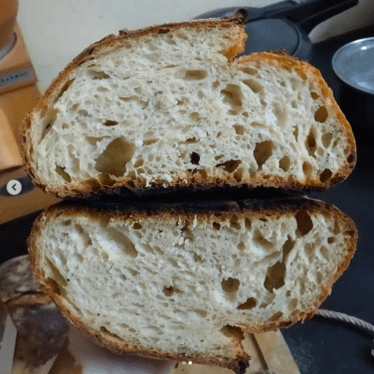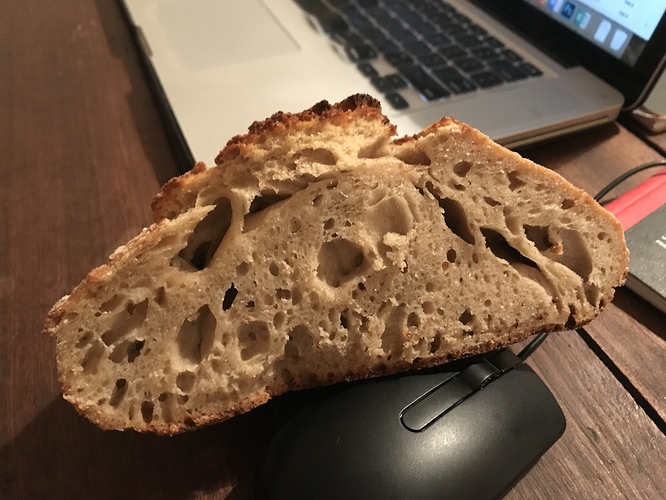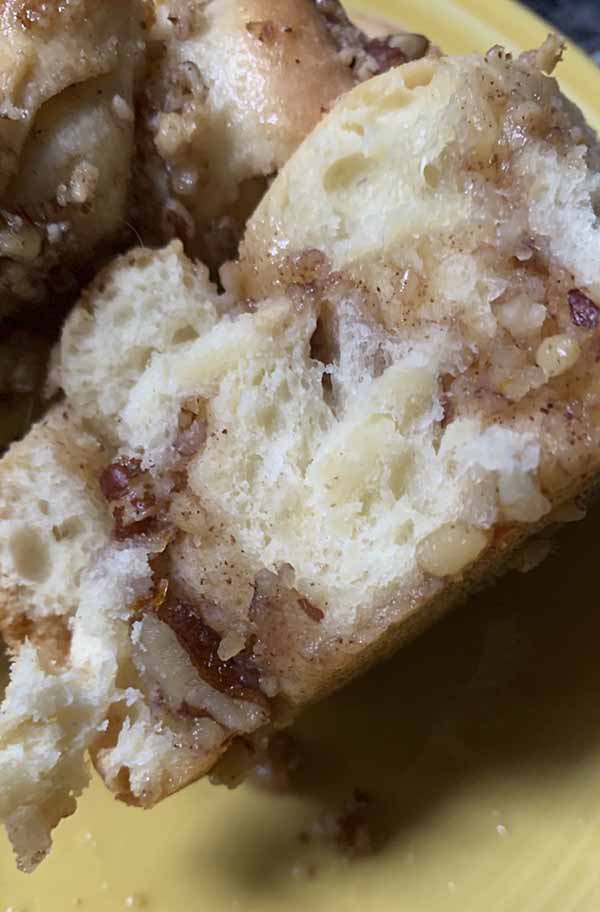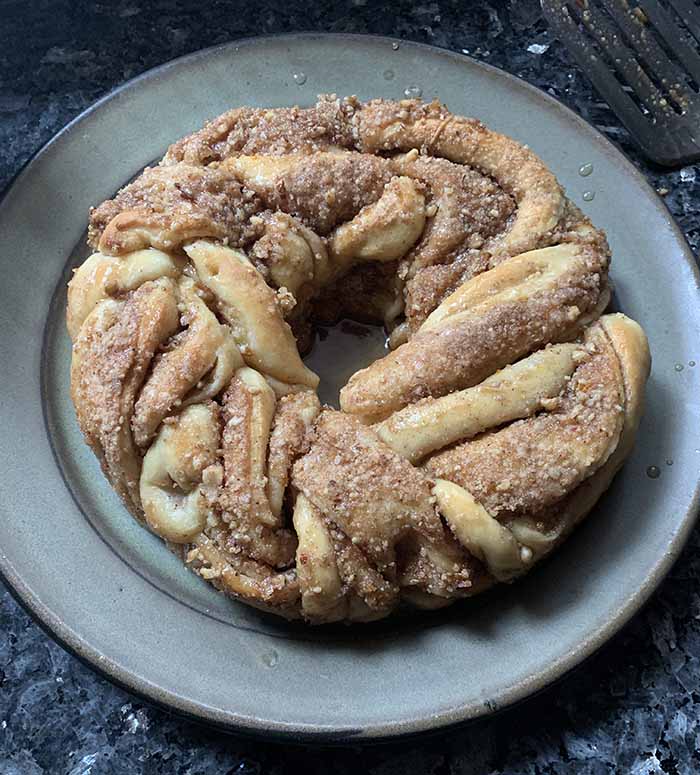Tried this recipe with all Breadtopia gear, great results, used a 10 day old homemade sourdough starter… Thanks so much for having all the best equipment on one site and the recipes. 20190118_233840|281x500
I baked this today, with some modifications. I have a very active starter and it was hot in Cape Town SA and we don’t do aircon cause reasons, so I used an extra two cups of rye flour in addition to everything. Also because my sourdoughs with this site keep overrising, needing more flour and a second rise to be cool, I watched it for six hours instead of leaving it for 12. Turns out it was a climate thing. The breads came out gorgeous. Not as sour as I like, so perhaps I’ll refrigerate for a few hours before the rise next time and see. [Uploading: sourdough success.jpg…
I use an ovenproof dish - thick cast iron with a glass lid. I think it is important to be able to heat the baking implement and and throw the dough in and seal it to mushroom. I think anything you can heat and slightly seal would be better than an open oven. Also any pizza oven would work great. Or a baking pan with holes in the side in a convection oven or gas oven.
Variations??
I love this low-recipe! have used it to make great bread and focaccia.
Hoping now to make some hot cross buns, but wondering if anyone has played win this recipe in that way. I’m thinking I would add the extra ingredients before the brief stretch and fold, then proof as buns, but it probably needs some extra flour to make it less wet and more mouldable.
There is no reason you can’t make “buns” from the recipe as you suggest.
Hot cross buns are usually an enriched, almost brioche dough so you might also look at @Fermentada’s Milk bread/roll recips which is a soft, tender, slightly sweet dough.
I make an enriched brioche kind of sourdough and use the same sweet stiff starter: 90 g flour, 25 g active starter (whatever your starter is), 40 g water and 20 g sugar. I usually mix this in the evening.
Next morning add the sweet starter to:
1/2 cup milk
130 g sugar
3 eggs
1.5 tsp vanilla
482 g flour
pinch salt (more if using unsalted butter)
6 T butter
I then use a stand mixer for this dough so not exactly a no knead and if you want to combine by hand go for it. For myself, combining the eggs, sugar and butter is easier with the mixer. After mixing, I let it sit at room temp for 2-4 hours and then into the frig for 24 (ish) hours. Let the dough warm, roll / shape as you want. I make cinnamon rolls, babka like sweet roll, “Danish”, and doughnuts with this dough. If I was using it for hot cross buns, I’d add the spices and raisins after mixing before refrigerating … I think. If you go this way, the dough seems a bit stiff and like it hasn’t risen much out of the refrigerator, but as it warms it softens and gets a bit puffy and I get good rise and nice soft interior.
Sourdough-hokkaido-milk bread/Roll recipe
Oops … the first link was the comment thread, above is the recipe link
There is a completely no knead brioche dough here.
I made this recipe (actually 1/4 or 1/2) before I started making sourdough. I’m fairly sure you would be fine with regular starter (110 grams, 1/2 cup) in place of the yeast if you didn’t want to deal with the sweet starter.
I neeeeeed to make this. It looks so good.
I get too excited and indecisive about the possibilities: cinnamon rolls, pecan sticky buns, baklava babka (is that what’s in the pic?), plain brioche, raisin rolls. Obviously the solution is to make a double batch, so at least I get two of my choices haha
Yep, that’s the interior of the baklava babka  It is such fun to make. I’ve made the cinnamon nut with honey syrup and also an orange-cranberry with orange syrup. Like your naan babka, I think the filling gets distributed better in the babka roll/cut/twist than in cinnamon rolls, but there is room for all of them !!
It is such fun to make. I’ve made the cinnamon nut with honey syrup and also an orange-cranberry with orange syrup. Like your naan babka, I think the filling gets distributed better in the babka roll/cut/twist than in cinnamon rolls, but there is room for all of them !!
Since Melissa brought it up … the baklava babka was originally Smitten Kitchen’s Baklava Babka. I adapted it for sourdough.
That’s gorgeous! Thanks for the sourdough conversion and the smitten kitchen link for the filling part of the recipe.
I have a thing with baklava where I don’t max out on eating it the way i do with a frosted cake after a small slice, for example. I’ll probably make this late next week, and I’ll find out where it lies on the could-eat-this-forever scale 
When you made an orange cranberry one, did you use an orange cranberry marmelade for the filling?
So many possibilities, strawberry cream cheese is coming to mind too.
There is also @Eric’s Easy Bake Series numbers 3 & 4 which presents an enriched dough and tutorials for using it to make sandwich bread, dinner rolls, hot dog buns, and hamburger buns. Not entirely no-knead, but not far from it (and my guess is that you could get by without the kneading that @Eric does and still get fine results [maybe increase the hydration a few percent…]).
I think marmalade would be great! I used a citrus-zest-juice mix and dried cranberries:
I mostly eyeball this but approx.:
1 cup sugar
1 T zest
mix the zest into the sugar so the zest releases oil, mixes in and smells wonderful!
add some juice (1 T) … not much you don’t want things runny
Softened butter like for cinnamon rolls, then the sugar zest mix and then the fruit (whatever looks good to me)
I think I’ll post all of this as a Reader Recipe: sourdough brioche or something…
I think if was me, I’d go for this “easy bake” dough for hot cross buns… a lighter enriched dough than the brioche.
Gotcha on the orange zest/fruit/butter eyeballing 
In Peter Reinhart’s Bread Baker’s Apprentice, he gives three brioche recipes:
Rich Man’s >80% butter (relative to flour weight)
Middle Class >50%
Poor Man’s >20%
The smitten kitchen dough is about 18%, and the Hokkaido milk buns are 19% ignoring the flour in the starter.
They’re so rich and delicious, it’s hard to imagine 50% let alone 80% but someday I’ll give it a try.
A quick scan of hot cross bun recipes online has them around 10-15% butter.
All of which is to say that there is lots of delicious variation…
…and after looking at those Easy-Bake rolls, hamburger and hotdog buns, seeing how quick they can be made, knowing how much better they would taste than storebought, I will never ever buy them again for backyard cookouts!
There seems to be a lot of discussion about howl to retain the “sour” in sour dough. Some say a longer ferment time, a cold ferment, more sour dough starter, less sour dough starter, wetter dough, dryer dough etc etc. I have tried them all and found “one” more suggestion at another website that I thought I should try. And it worked. First let me say I started my our sour dough using breadtopias suggested approach and had sour dough for a loaf or two then it lost all “sour” properties. But still made a great loaf of bread using this “No Knead Method”.
From the other source I found that by taking 1/4 cup of my starter (I cant legitimately call it Sour Dough starter” because it was not sour, and adding 1/2 cup of Water, and 1 cup of AP Flour, mixing and letting is sit on the counter, and feeding it 2x a day for about five days - the sour comes back.
When feeding, take 1/4 cup of the newly started starter, and repeat the above additions And discarded the left over (or use it for something else). Again 2x a day for five days - I actually started feeding the starter on Monday morning and on Thursday Morning then began using the No Knead Method to begin making the bread. Mix and rest for 18 hours, fold the dough and rest for 15 minutes then form the boule and let rise for 2 hours. Bake.
This method has now worked for me a couple of times. Previously I had been making the sour dough NO Knead Method for a couple of years and continually lost the “sour”. This works
hello my name is Bekah,
we live 6800 altitude…
any suggestions, for altering the recipe ?
Hi Bekah! I live at 3300 but my mom lives at 8500. When I bake at her house, she always reminds me to keep an eye on the rise (it goes faster) and maybe a bit more liquid (the air is drier, the flour will absorb more water).
Variances in flour to water happen for all of us depending on type of flour, the day, each kitchen. With a new recipe, I like to add dry to liquid and I can stop adding flour if the dough seems “right”. It is much easier to add more flour to a too wet dough than try to add moisture to a too dry dough.
This is a pretty forgiving recipe but if you are a new baker and/or new to your altitude, watch the video and go for the look and feel in the video even if you add less (or more?) flour. I’d go with the same temps in the recipe but you may have to bake a little longer. Check temp the first time if you have a thermometer.
Also, if you have a scale, weigh flours vs using volume for most accurate measure.
Hello, I tried out this recipe for the first time, with some mods for my climate and flour type (humid tropics). I used about 90% maida (Indian local APF) and 10% of my own home-grown, stone-milled whole wheat. I reduced the water to 400g. I did two s&f, and then left it outside on the balcony overnight, about 8 hours (18-20C). It was beautifully fermented. I tried the coil folds, which were a bit tricky, then proofed for about 90 minutes. Preheated the dutch oven in my toaster oven (no gas oven, alas!) at 250C for 30 mins, then baked at 250 for 20 mins, and with the lid off for another 30.


I am happy with the crust and oven spring, and the crumb is decent. My problem is the internal temperature after 50 mins is 99.8F, but the crumb remains gummy and underdone. This has happened several times with my recent bakes, all in a DO, with 65-75% hydration. Why does that happen? Does the smaller environment of the toaster oven heat up the crust too quickly and not allow the crumb to be done? But then why does the inner temp register “done”? In fact, when I put the digital thermometer in it came out with sticky. After several hours I cut the loaf and it has got drier. But I would appreciate suggestions on how to tinker with OTG/Toaster oven temps with high hydration doughs, to bake the crumb better.
Thanks SO much for all the videos - I have been watching for a long time, but finally got a starter going well.
Your bread looks fantastic. The internal temperature does need to be over 205F though. But maybe you meant to write that the inside is over 99 C (not F as you wrote).
Your crumb certainly looks nicely done. And the inside of the bread needs time to cool down, so pulling out a damp thermometer is not uncommon.
If you don’t have a baking vessel that fits in your toaster oven, maybe wrap the bread in foil part way through the bake so that it doesn’t continue to brown while the inside finishes cooking.


